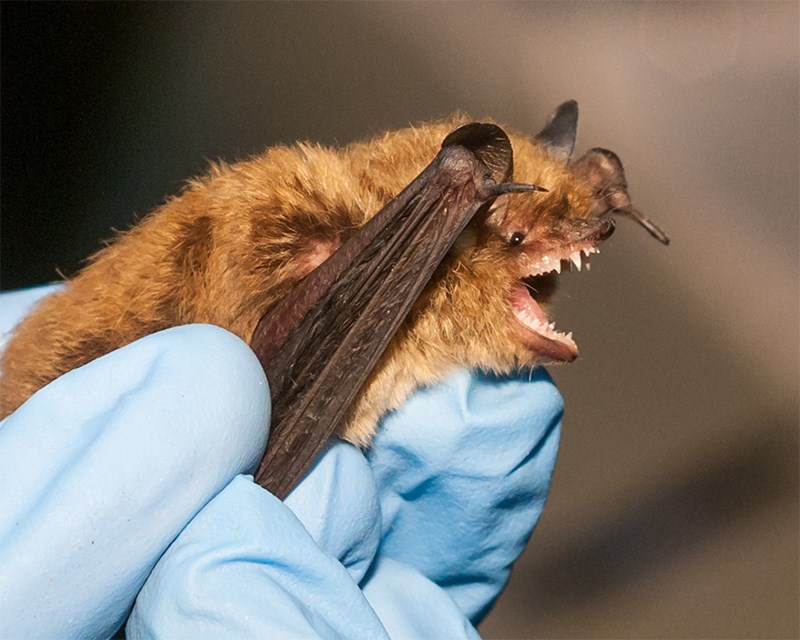Bats are the new bees as conservationists seek to protect the flying mammals that are so important to the ecosystem for pollination and insect control.
And in the Tri-Cities, that means building a bat “condo” at Colony Farm Regional Park for the creatures to ensure they have a safe place to raise their young.
“Bats, when you learn about them, are very unique,” said John Saremba, the bat team coordinator for the Burke Mountain Naturalists (BMN).
His group monitors local bat colonies and provides education programs to foster an awareness among Tri-City residents about the creatures. This is necessary, Saremba said, because bats historically have received a bad rap, resulting in little research and few resources being put towards their protection.
“For a species that is so important ecologically, we have very little funding put towards research. It’s because they are nocturnal and a lot of people have a lot of misinformation and fear of bats,” said Saremba, who has come to love the tiny creatures, some of which are no bigger than a man’s thumb despite their wide wingspan.
On a hot day in August, Saremba took The Tri-City News to view the bat condo built with more than 200 volunteer hours by BMN bat team members and their supporters. Designed by Kiyoshi Takahashi, the bat condo can house up to 1,000 bats and has a large cavity where baby bats can learn to fly. It cost $12,000 to build, with a grant from the Pacific Parklands Foundation.
“This condo is unique because it offers a diversity of microclimates,” Saremba said, explaining that female bats need warmth to reproduce and look after their young.
So far, the condo has drawn the interest of a only few bats while most of the colony is housed in a smaller bat box a short distance away at Colony Farm and some local bats have relocated to another roost recently. The solitary males, meanwhile, are in several locations around the area.
As bats come to explore the new condo, Saremba expects the wooden structure will get well used — it’s on their flight path and offers safe lodging.
BMN’s bat team knows the habits of local bats because its members visit the colonies at each of the Metro Vancouver parks — Colony Farm, Minnekhada and Widgeon Marsh Regional Park reserve in the Tri-Cities — four times a year to count the mammals. They also monitor bat boxes placed in parks and greenbelts in Coquitlam, Port Moody and Port Coquitlam.
And as volunteer activities go, bat counting is one of the most peaceful and rewarding, said Saremba.
Just as the sun is about to set, the park empties out and volunteers begin their vigil. For over an hour, they will stand outside the bat box and use clickers to count the creatures as they they fly past them in the night. “It’s just a delightful experience,” Saremba said.
The public is invited to participate and those who join in are surprised to learn about bats, their contributions to the environment and even how tender they are towards one another.
Sadly, their habitat is disappearing, something volunteers are hoping to address through the construction of bat boxes, and a deadly white-nose syndrome fungus is on the march through North America. It has already been detected in Seattle and could move up here, although Saremba’s team is paying close attention to the issue and has collected guano — bat excrement — for analysis on behalf of the BC Bat Community Program.
With luck and community interest, the local bat colonies will thrive.
• For more information about upcoming bat monitoring sessions, visit www.burkemountainnaturalists.ca.
By the Numbers
Bats have been making their home in the Tri-Cities for generations and volunteers count them each year to determine their numbers. Here are the high count numbers for 2018,
Colony Farm Regional Park, one roost site, 800 to 820
Minnekhada Regional Park, two roost sites, 1,000 to 1,100
Widgeon Marsh Regional Park Reserve, three roost site, 550 to 600
What type of bats are here?
The Burke Mountain Naturalists' Bat Team has encountered the following bat species: Yuma myotis and little brown myotis, hoary bat, big brown bay, Californian myotis, long-eared myotis, long-legged myotis, Townsend’s big-eared bat (Minnekhada Park only).
Upcoming
Find out about the next bat monitoring event along with other volunteer opportunities and nature outings at www.burkemountainnaturalists.ca under news and events. “Bats of Minnekhada” events are scheduled for this Friday, Aug. 17 and are an excellent way for people to learn about bats and then watch them emerge from several roosts. More information and registration for these events are available at www.metrovancouver.org under Events and Calendar.



